dyzzypyxxy said:Pumpkins here are left on the vines until the vines die. Where they are grown commercially, (not in Florida) they let the first few frosty nights kill the vines, leave the pumpkins sitting in the fields and harvest them all in October, in time for Hallowe'en and Thanksgiving.
I think a decorative pumpkin can be harvested as soon as it looks as pretty as you want it to. But the longer you leave it on the vine, the more likely you will have viable seeds to harvest.
davidsevit said:i am talking about variety not only in color but also size.
if i do as you said get some flowers or buy some someone said you dont know what is in the seeds produced by these flowers.
i have now one big(for example)flower and one small.is there anything going to happen between them if they are close enough?
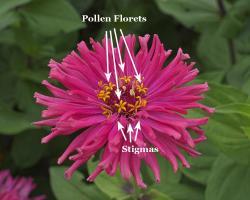


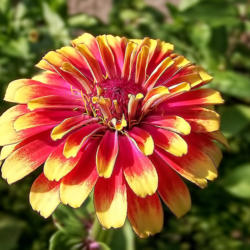
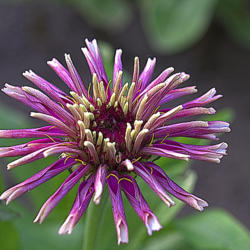
RickCorey said:I was thinking the same thing Elaine said. I think that gardeners must have been the original colonial imperialists.
No matter how much space we have, we fill it. Full!
Then, like weeds, we start to encroach on nearby yards ...
David, just once I had the chance to walk around some redwoods. They had a very potent feeling that was like a cathedral or synagog or mosque. A really, really, REALLY holy cathedral or synagog or mosque.
As a kid, religious services in churches often did not seem very special to me. Then, at some Boy Scout camp-out, they happened to bring in a priest on a Sunday for the Catholic boys. It was totally ad hoc and amateur-hour. He balanced a flimsy card table on some uneven terrain in a small, partly open space amongst the trees.
Then, suddenly, the Sun, the silence, the trees, breaths of breeze and occasional birdsong turned into a jaw-dropping Holy Presence of Something. Nature, Yahveh, Jehovah or whatever - I don't pretend to know that kind of detail - the divine Presence in that woody clearing made cleawr what religious services try to accomplish.
I guess that was off-topic.
ZenMan said:
I grow zinnias and breed them as a fun hobby. Zinnias are normally pollinated by one species or another of bees. The bees do not intend to do pollination, their intent is to gather nectar or pollen (liquid and solid food for them) and some pollination can occur by accident. But bees are not at all efficient at pollinating zinnias. Just planting two zinnia plants next to each other is an unreliable way to hybridize them.
I recommend that you "be the bee" and do the pollination yourself. The male and female parts of a zinnia flower are relatively easy to access, so you can do a much better job than the bees, because they don't have a clue about pollination, and you can know exactly what is going on.
The male parts of a zinnia flower are the pollen florets, which produce pollen in the morning. The pollen florets are fuzzy yellow starfish shaped organs. The female parts of zinnia flower are the stigmas. They are thin yellow Y-shaped organs at the base of each petal. The Pollen Florets and Stigmas are annotated in this picture of a zinnia bloom.
You probably already know that you can see a larger version of the pictures in All Things Plants by just clicking on them. And you can make that picture a bit larger still by hitting your F11 key to temporarily remove your browser's heading material. Hit the F11 key again to restore your browser's headings. Scroll to the lower right-hand corner of the big picture to click on the little arrow to close the big picture and be back here.
You can cross pollinate two different zinnias by transferring pollen from the Pollen Florets of one bloom onto the Stigmas of another bloom. Or, if you want to self a zinnia bloom, you can distribute its pollen over its stigmas. By transferring the pollen yourself, you can get very high seed yields. Incidentally, the unused pollen florets can form a selfed "floret seed" at their base. The florets seeds look different from the petal seeds. You can transfer the pollen with an artists brush, or by picking the floret with tweezers or forceps and using the pollen floret itself as a brush to apply pollen to stigmas.
There are many, many kinds and colors of zinnias that exist, and an almost astronomical number of different crosses that you can make between them. Hopefully you can find sources of different zinnias available in Israel. Some combine two or more colors on each petal, like these examples.
- Zinnia 'Whirligig'
- Uploaded by ZenMan
- Zinnia 'Zig Zag'
- Uploaded by ZenMan
- Zinnia 'Whirligig'
- Uploaded by ZenMan
If you have questions about any of this, feel free to ask.
ZM

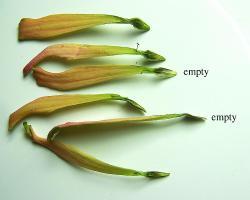
davidsevit said:
rick hebrew please.....like my students say.....i did not understand anything.......really
ZenMan said:Hi David,
" do i need to change the plants location?
now they are on a very sunny patio? "
Zinnias need full sun, which usually means at least 8 hours of direct sunshine per day.
" is it a good time to cross pollinate now? "
Yes. Now is a good time to cross pollinate. Early in the morning when the pollen florets are just opening, you can sometimes see some yellow powder in the center of the floret, and that is the most effective time to use the floret. But there is usually some pollen left in the fuzzy arms of the floret for several hours. It takes just one grain of pollen on a stigma to fertilize it. If today's pollination of a stigma is successful, the stigma will be withering tomorrow and the next day it will be obviously dead.
However, if pollination of a stigma didn't "take", the stigma will remain yellow and alive, which gives you a second or a third chance to get it pollinated. An unpollinated stigma will remain obviously alive and yellow for 10 days or more, which gives you several chances to get it pollinated. I part the petals with my fingers to examine all of the stigmas to see which ones have been "fertilized" and which ones are still alive and yellow, and I apply pollen to the fresh ones. By doing that on a daily basis you can get most of the stigmas "fertilized". You can do a better job than the bees.
As soon as the stigma is fertilized, a tiny embryo in the attached seed starts to grow. The embryo will reach maturity in about three weeks. At that time the petal will still be alive and good looking. If you wish, you can pluck the seed and plant it then, or you can dry it on a newspaper or paper towel or whatever is convenient and store it for use next year. It is rather obvious which petals have a viable green seed attached and which ones are "empty". Notice that the petals are still alive and have their color.
I don't know how long your growing season is in Jerusalem. Here in Kansas we can get a killing frost any time in October, so I am very close to my cut-off time for planting zinnia seeds outdoors. In my experience, green seeds can survive a light frost, but a really severe freeze would probably kill them.
There are several advantages to saving green seeds instead of the classic waiting until the flower head dies and becomes brown. Green seeds let you avoid pre-germination in the seed head if there is a prolonged rainy period. Green seeds reduce the risk period from seed eating birds (that is a risk here in Kansas). And, if there is still time, green seeds let you grow a second generation of zinnias in your growing season. It can be very satisfying to cross pollinate your zinnias and then see the results the same year.
If you have questions or need clarification about any of this, don't hesitate to ask.
ZM

RickCorey said:RickCorey said:
It won't be very complicated for me, they just might be confiscated.
The delay is just my procrastination.
confiscated? procrastination?
Sorry, my bad!
I don't know if this will work:
Sending seeds won't be difficult for me. But the Israeli customs people might הוחרם them. Take them and throw them away and never send them to you. קאָנפיסקירן
The delay is because I לְהִתְמַהֲמֵהַ - I get lazy, forget, and do other things first. אָפּלייגן
ZenMan said:
I grow zinnias and breed them as a fun hobby. Zinnias are normally pollinated by one species or another of bees. The bees do not intend to do pollination, their intent is to gather nectar or pollen (liquid and solid food for them) and some pollination can occur by accident. But bees are not at all efficient at pollinating zinnias. Just planting two zinnia plants next to each other is an unreliable way to hybridize them.
I recommend that you "be the bee" and do the pollination yourself. The male and female parts of a zinnia flower are relatively easy to access, so you can do a much better job than the bees, because they don't have a clue about pollination, and you can know exactly what is going on.
The male parts of a zinnia flower are the pollen florets, which produce pollen in the morning. The pollen florets are fuzzy yellow starfish shaped organs. The female parts of zinnia flower are the stigmas. They are thin yellow Y-shaped organs at the base of each petal. The Pollen Florets and Stigmas are annotated in this picture of a zinnia bloom.
You probably already know that you can see a larger version of the pictures in All Things Plants by just clicking on them. And you can make that picture a bit larger still by hitting your F11 key to temporarily remove your browser's heading material. Hit the F11 key again to restore your browser's headings. Scroll to the lower right-hand corner of the big picture to click on the little arrow to close the big picture and be back here.
You can cross pollinate two different zinnias by transferring pollen from the Pollen Florets of one bloom onto the Stigmas of another bloom. Or, if you want to self a zinnia bloom, you can distribute its pollen over its stigmas. By transferring the pollen yourself, you can get very high seed yields. Incidentally, the unused pollen florets can form a selfed "floret seed" at their base. The florets seeds look different from the petal seeds. You can transfer the pollen with an artists brush, or by picking the floret with tweezers or forceps and using the pollen floret itself as a brush to apply pollen to stigmas.
There are many, many kinds and colors of zinnias that exist, and an almost astronomical number of different crosses that you can make between them. Hopefully you can find sources of different zinnias available in Israel. Some combine two or more colors on each petal, like these examples.
- Zinnia 'Whirligig'
- Uploaded by ZenMan
- Zinnia 'Zig Zag'
- Uploaded by ZenMan
- Zinnia 'Whirligig'
- Uploaded by ZenMan
If you have questions about any of this, feel free to ask.
ZM. There are some nice zinnias growing in a public garden. Can i pick two different colors with leaves. Put them in a vase with water at home. And soon cross polinate them. Meaning that putting tjem in water in full sun will mot disturb the natural cucle?

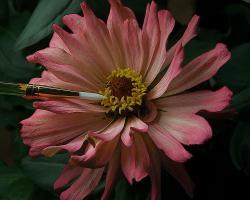
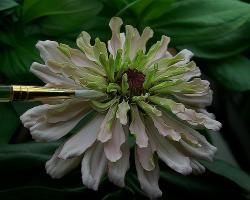

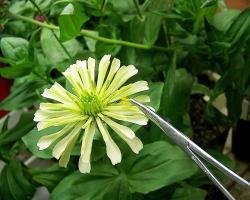
dyzzypyxxy said:Yes, I was going to say that it is not really allowed to pick flowers from public gardens here. If everyone did that there would be no flowers.
So ZenMan's idea to collect some pollen florets is much better and leaves the flower for others to enjoy.
ZenMan said:Hi David,
" your description of putting pollen in a small container sounds funny to me "
Well, I was describing putting pollen florets in a small container. The only way I transport pollen grains themselves is in the bristles on the end of an artists brush. The pollen itself is a fine powder, with each grain of pollen being almost microscopic.
" ...is it not easier to pick the whole flower or you think it is not moral? "
I wouldn't classify it as a morality issue. With respect to a community garden, the rules of the garden or the municipality would govern you. If they don't mind you picking the flowers, then I suppose it would be all right. But if you go to the garden and find that somebody else has already picked all the flowers, you might want to rethink the rule.
" ...how about picking the flower and then rubbing the whole flower 1 on top of flower 2? "
If flower 1 had a lot of open pollen florets on it, then rubbing it on flower 2 could conceivably pollinate some of the upper exposed stigmas on flower 2. But that is reminiscent of the fable about killing the goose that lays the golden eggs. A zinnia bloom develops over a period of several weeks, and produces new stigmas over a period of several weeks, and can produce new pollen florets daily over a period of several weeks. So picking a zinnia flower to use its pollen would lose all those future pollen florets that it would produce in the coming days and weeks. That would be logically similar to eating your seed corn. You might have a good meal, but at the cost of a whole corn crop, and future starvation.
Maybe I shouldn't mention this, but if the community garden management doesn't mind you harvesting pollen florets for your own use, they might also not mind you plucking a few of the lower petals, which might be attached to viable green seeds. If you were discrete, no one might notice a few missing lower petals.
ZM
